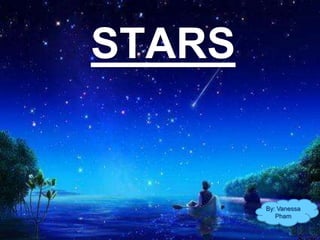
Stars
- 1. STARS By: Vanessa Pham
- 2. What is a Star? A star is a huge ball of gas held together by gravity. The central core of a star is extremely hot and produces energy, this energy is released as visible light, which makes the star glow. Stars come in different sizes, colors, and temperatures. Our Sun, the center of our solar system, is a yellow star of the average temperature and size.
- 5. The Yerkes Luminosity Classes
- 6. Shooting & Falling Stars A "falling star" or a "shooting star" has nothing at all to do with a star! They are both names used for hundreds of years to describe meteors. When a meteor appears, it seems to "shoot" quickly across the sky, due to its small size and intense brightness people might think it is a “shooting” star. If we ever spot a meteorite (a meteor that makes it all the way to the ground), and see where it hits, it's easy to think that we just saw a star "fall" hence the common term “falling star.”
- 7. Constellations A constellation is a group of stars that, when seen from Earth, form a pattern. The stars in the sky are divided into 88 constellations. Constellations are used as mnemonics, to help poets, farmers and astronomers tell which stars are which, by breaking up the sky into more manageable pieces.
- 9. 5-pointed Star Design Why do people draw a Star with 5-points when they are just balls of gas? Stars have been represented differently throughout History. Some cultures represents Stars as the way they were seen in the sky, as small dots or small circles. The 5 pointed star might have originated from the way the Egyptians represented the star in hieroglyphics. If you look at a really bright star sometime you might notice that it does appear to have lines coming out from it. (diffraction spikes and appear because of the way the light enters the eye.)
- 10. Pictures